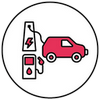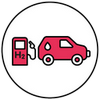Fleet decarbonisation is an important part of achieving Net Zero targets. This guide highlights best practice and some of the pitfalls of fleet decarbonisation
Fleet decarbonisation is an important part of achieving Net Zero targets. This guide highlights best practice and some of the pitfalls of fleet decarbonisation.
Develop your organisation strategy
A fleet decarbonisation strategy is a comprehensive overview of the approach, benefits and outcomes of reducing or eliminating the carbon emissions produced by a fleet of vehicles.
A strategy needs to have buy-in from decision makers before progressing to the detailed planning stage. Having a strategy that is signed off by decision makers will support changes and allow budgets to be assigned. It will need to be aligned with other policies and strategies within the organisation.
A fleet strategy needs to consider the case for change and the wider potential benefits of a low carbon fleet.
Benefits of fleet decarbonisation
Decarbonising fleets have a range of benefits and co-benefits that should be considered during business case development.
| Benefit | Summary | Detail |
|---|---|---|
| Financial | Provide cost neutral low carbon alternative | Opportunities to upgrade to low carbon alternatives for marginal differences to current costs can be provided through local energy projects. |
| Health and Wellbeing | Reduce air pollution | Creating cleaner air lead to a number of health benefits as well as increasing the quality of life of people in the local area. |
| Health and Wellbeing | Reduce noise pollution | High levels of noise can lead to stress and mental health issues. Lowering the noise level in an area can have positive benefits |
| Netzero | Increase awareness of council action towards NetZero | Local Authorities are working hard to deliver carbon reduction plan both across their own assets and also in their communities. Increasing awareness of activities and successes can be important part of creating confidence and momentum towards Netzero in a local area. |
| Netzero | Reduce carbon emissions | Reducing carbon emissions from all parts of transport, business and homes is the primary way of achieving Netzero. Reduction may be through active changes to energy supply, generation or demand management |
Build your fleet transition plan
The fleet transition plan provides a structured roadmap for transitioning an existing fleet of vehicles to low carbon alternatives.
Fuel options
Summary of fuel options
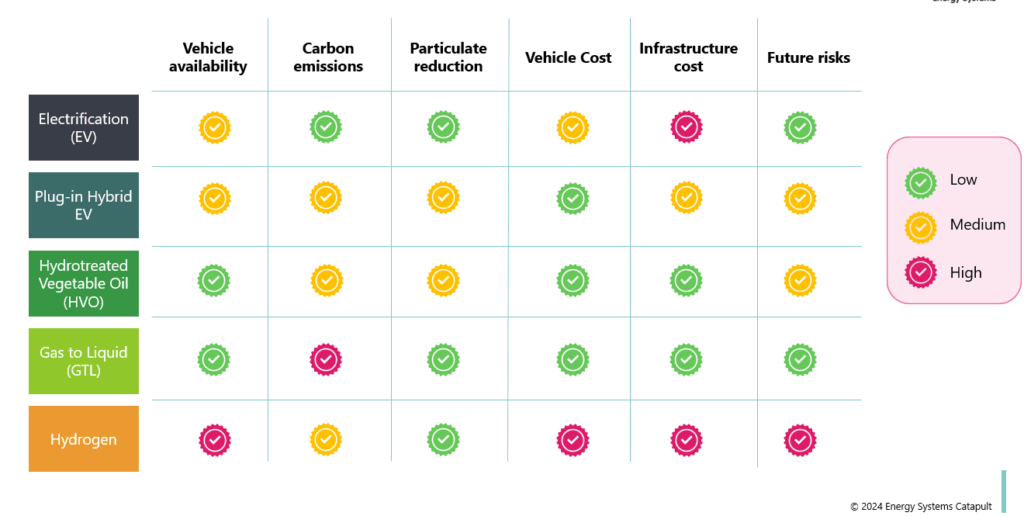
Business models
In deciding how to deliver your fleet decarbonisation you will need to understand how the business model will work, this is different to and informs the business case. The business case gives information to decision makers while the business model explores how all the components and elements fit together to create a robust business case.
Business model options
In order to deliver on specific projects to achieve their EVI Strategy, local authorities (LAs) may choose to procure Electric Vehicle Infrastructure (EVI).
One of the key decisions that must be made in the procurement process is selecting an appropriate commercial arrangement. This is the division of investments, ownership, risk, and responsibilities for between the LA and a service provider.
Note: Other documents refer to this as operating models, procurement options, ownership options or ownership models.
The LEVI Procurement Forum has identified four common and successful arrangements in-use in the market:

The Business models in this section have been taken from National EV Insight & Support (NEVIS) commercial arrangements.
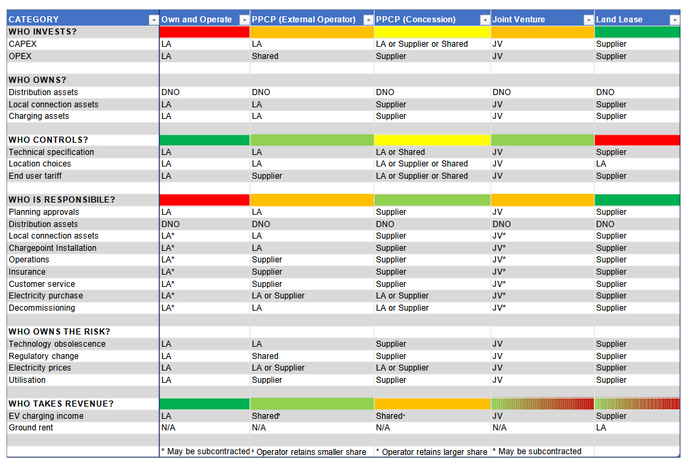
Derived from https://nevis.cenex.co.uk/repository/commercial-arrangements
Vehicle options
In order to get the optimal vehicle solution for each service you may need to review the usage of the entire fleet. The best way of getting the data for this is to implement telematics within your fleet. If you are retaining some diesel vehicles through use of HVO or GTL then some of the following items may not apply.
Data requirements
Telematics is a method of monitoring cars, trucks, equipment and other assets by using GPS technology and on-board diagnostics (OBD) to plot the asset’s movements and record the usage profiles . This is also known as fleet tracking or GPS vehicle tracking, telematics is an essential management tool for fleets.
The data will help understand the usage profile that new fleet vehicles will need to fulfil.
Review market for available models to meet service requirements
The next step is matching available vehicles to service requirements. Unless the fleet manager is very experienced in commercial vehicle relationships it may be advantageous to go through a lease company or a specialist who can review the wide range of vehicle manufacturers and vehicles that are available.
Some vehicles may not have direct replacements. Where this is the case, you could consider options to change the service delivery profile. eg Gritter lorries which require high levels of availablity in cold weather.
Some vehicles may provide enhancements over the existing ICE platforms. In this case review if the service profile can be adjusted to take advantage of this. e.g. some models of EV waste collection vehicles have rear or 4 wheel steering, and may be thinner which allow for access to narrower streets than existing vehicles.
The best way to get a greater understanding of the options and lessons is to look at case studies provided by other local authorities. Net Zero Go is collecting and sharing case studies. Some are available in this guide.
Please share your own case studies with us to share with the wider community.
Create good relationships with manufacturers and vehicle providers
The vehicles in your fleet have a long lifecycle, a good relationship with the vehicle provider (leaser) or vehicle manufacturer is essential to procuring, operating and maintaining the fleet over their lifetimes.
Understand the warranties associated with the batteries in EV vehicles and full lifecycle costs
The lifecycle of an electric vehicle including resale value can be affected by the warranties on batteries in the vehicles in a way that is different to conventional ICE vehicles. Manufacturers are providing longer warranties as time goes on as the sector matures. The operational lifetime of the vehicle may be longer than the warranty offered and so the risk for reduction in range, or failure of the battery will be carried by the local authorities (or leaser if that is the model).
Current resale value of vehicle with expired warranties are very low so this needs to be include in the full lifecyle costs of ownership.
Review required staff training to maintain and operate new vehicles
Maintaining electric vehicles requires a new set of qualifications. A minimal Level 3 Award in Electric/Hybrid Vehicle System Repair and Replacement is required to work on electric vehicles wtih level 4 required if you are expecting to replace or maintain batteries directly. Some vehicles may need a different maintenance schedule to conventional ICE vehicles.
All vehicle operators will need to be upskilled to use the new vehicles in a safe and efficient way, including how to charge, drive and operate any attached machinery.
Go for the low hanging fruit first and pilot with small numbers
Getting familiar with procuring and operating electric vehicles is an important part of building a plan.
Consider starting with a small amount of vehicles in a single location, to get used to operating, charging requirements and vehicle interoperability with services and the rest of the fleet. Ideally the pilot would not require capacity upgrades from the local distribution grid. A number of charging points and billing mechanisms could be tested, as well as developing relationship with potential suppliers.
Consider a transition plan for each type of vehicle
Some vehicles may be easier to transition given the current market and so it will be necessary to include a range of options both short term and long term in your plan.
Click the areas below to review the different transitions for different vehicles.
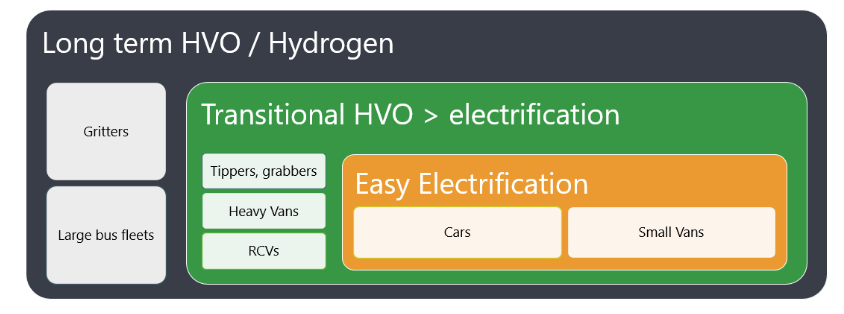
Infrastructure
Delivery of the infrastructure to operate a new type of vehicle can be the most difficult part of the process. Upgrading capacity in the grid and equipping depots can be expensive and subject to blockers, delays and constraints
Fully understand your depots and vehicle parking locations
Your depots and parking areas will not have been designed with new infrastructure in mind and in some cases will have been constructed many decades ago. It is possible that concrete yards, location of liquid fuel pipelines and fuel tanks and other underground services can impact the options available to you to install the capacity for charging infrastructure. Existing car parks where they are multi-storey have weight limitations that constrain vehicle types and charging infrastructure. Make sure you also have a clear understanding of the surrounding context with regards to land use and ownership, and other potential users of the local network as these can provide challenges or opportunities around upgrading network infrastructure.
Understand the service and vehicle requirements
Are the locations going to be available for public charging alongside fleet vehicles, this is common in council office car parks. This will add to the requirements for the charging pillars and billings systems.
Review available data on local distribution network capacity
Engage with your local District Network Operator (DNO) at an early stage. Each DNO publishes their own EV connection guides and also has an array of web-portal based tools (including capacity maps showing ‘demand’ capacity on their network) that can support an initial consultation or meeting with the DNO. However, many of these interactive maps may not function for the power required to electrify a whole depot so it is strongly advised that a meeting is convened directly with the DNO whereby a future application for power can be directly discussed.
Look for opportunities for supporting projects and infrastructure, including strategic site review
Installing charging infrastructure is a major change programme and this kind of inflection point is often a good opportunity to review site usage and service provision. There may also be good opportunities to integrate other low carbon technologies with the charging infrastructure.
Operation
Fleet operations for low carbon fleet on the whole can be very similar to a conventional fleet. There are a number of differences though.
- Managing charging times and scheduling is very important as service operating relies of specific vehicles at specific times. Operating conditions may well have an effect also.
- Cold weather operation can potentially reduce the operational range and charging times.
- Flood water can cause an issue to batteries is they become submerged, this may affect warranty considerations
- There are some reports of insurance issues with EV fleets, so make sure all safety codes and recommendations are followed while operating, charging and storing fleet vehicle.
Operational Benefits
- Electric vehicle have bought some unexpected benefits, such as refuse vehicle being much quieter, although in some case too quiet as residents have missed bin collections due to the silent running.
- Operational staff can be heard and may have to recognise that cheerful banter will carry further with very quiet vehicles
- Some types of eRCVs with rear or four wheel steer have led to reduced tire wear.
Further resources
Find all the resources mentioned in the guide and others that may be relevant.




